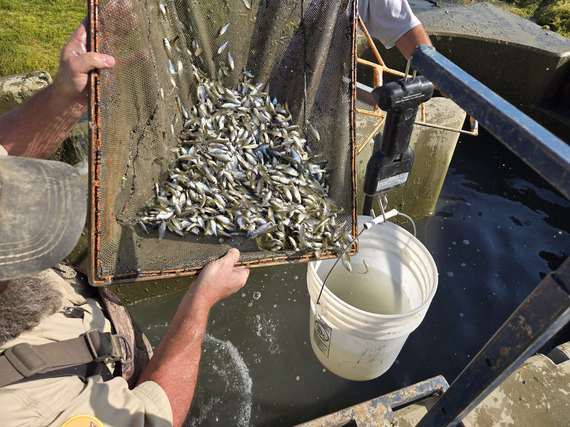
|
Montana Fish, Wildlife & Parks made significant gains recently toward ongoing efforts to provide and possibly rebuild the once-abundant crappie population at Tongue River Reservoir.
Thirteen ponds at the Miles City Hatchery were drained in early October to collect young-of-year (YOY) crappie produced in 2024. An estimated 265,507 YOY crappie (214,683 black and 50,824 white) ranging from 1.5-4.5 inches long were collected from the hatchery ponds and stocked at Tongue River Reservoir between October 7-17, 2024.
This is the second year the Miles City Hatchery has experimented with producing YOY crappie for stocking needs. In 2023, only white crappie were raised at the hatchery, yielding 9,800 YOY white crappie stocked at Tongue River Reservoir. In 2024, both white and black crappie were utilized in hatchery ponds separated by species. Ten to 20 adult crappie are placed into the hatchery ponds in April to facilitate natural spawning and YOY crappie production.
YOY crappie are extremely sensitive to mortality from handling stress, so aquiculture methods mandate YOY crappie are not collected until water temperatures fall below 60 degrees. The cooler water temperatures minimize stress and mortality from handling during collection, transport, and stocking. The timing of stocking efforts also maximizes the overall size of each fish, which can reduce predation rates by other fish species following stocking efforts. Larger stocked fish also have more energy reserves that aid in over-winter survival.
Some of the main goals for fish management at Tongue River Reservoir are improving crappie abundances, sustaining the popular crappie fishery, and bolstering the forage base (including crappie) for other predatory species. If annual crappie production is achieved at the hatchery, both white and black crappie will be stocked when annual trend sampling at the reservoir demonstrates low natural recruitment and crappie abundances are below 11.6 fish per gill net, as outlined in the Statewide Fisheries Management Plan.
August 2024 trend sampling at the reservoir showed a continued decline in crappie abundances, setting a new historic low catch rate for all gear types. Despite low catch rates of crappie, natural reproduction of crappie is still occurring in the reservoir, as indicated by low YOY catch rates.